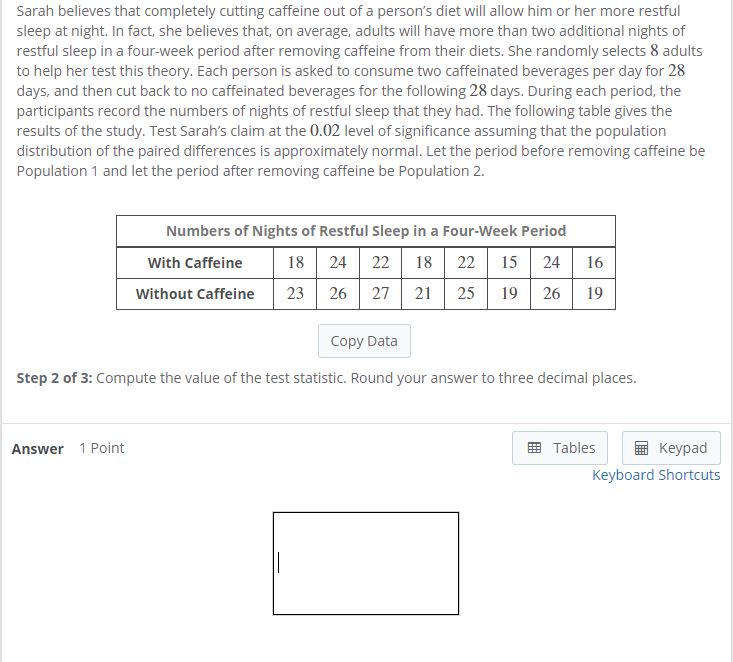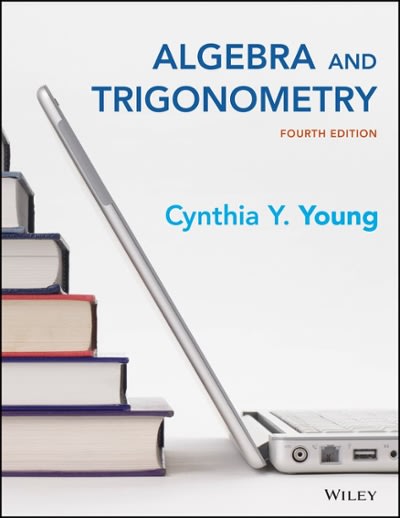Got stuck on these questions and really needs help here.
Sarah believes that completely cutting caffeine out of a person's diet will allow him or her more restful sleep at night. In fact. she believes that. on average. adults. will have more than two additional nights of restful sleep in a fourweek period after removing caffeine from their diets. She randomly selects 3 adults to help her test this theory. Each person is asked to consume two caffeinated beverages per day for 28 days. and then cut back to no caffeinated beverages for the following 28 days. During each period. the participants record the numbers of nights of restful sleep that they had. The following table gives the results of the study. Test Sarah's claim at the 0.02 level of signicance assuming that the population distribution of the paired differences is approximately normal. Let the period before removing caffeine be Population 1 and let the period after removing caffeine be Population 2. Numbers of Nights of Hestful Sleep in a Four-Week Period manna ------nn | Copy Data | Step 1 of 3: State the null and alternative hypotheses for the test. Fill in the blank below. HI] :d : 2 Ha JG 2 Answer 'lPoint % Tables ' I E Keypad | Keyboard-shortcuts CI 3: O s: Sarah believes that completely cutting caffeine out ofa person's diet will allow him or her more restful sleep at night. in fact. she believes that. on average. adults will have more than two additional nights of restful sleep in a fourweek period after removing caffeine from their diets. She randomly selects 3 adults to help her test this theory. Each person is asked to consume two caffeinated beverages per clayr for 28 days. and then cut back to no caffeinated beverages for the following 23 days. During each period. the participants record the numbers of nights of restful sleep that they had. The following table gives the results of the study. Test Sarah's claim at the [Ll]? level of signicance assuming that the population distribution of the paired differences is approximately normal. Let the period before removing caffeine be Population 1 and let the period after removing caffeine be Population 2. Numbers of Nights of Restful Sleep in a Four-Week Period mun-mun ------nn I Copy Data I Step 2 of 3: Compute the value of the test statistic. Round your answer to three decimal places. Answer lPoint E Tables I E Keypad H \"keysaa rd SHORES}: Sarah believes that completely cutting caffeine out of a person's diet will allow him or her more restful sleep at night. In fact. she believes thatr on average. adults will have more than two additional nights of restful sleep in a fourweek period after removing caffeine from their die. She randomly selects S adulE to help her test this theory. Each person is asked to consume two caffeinated beverages per day for 23- days. and then cut back to no caffeinated beverages for the following 23 days. During each period, the participants record the numbers of nights of i'ElIJl sleep that they had. The following table gives the results of the study. Test 5a rah's claim at the {1112 level of signicance assuming that the population distribution of the paired differences is approximately normal. Let the period before removing caffeine be Population 1 and let the period after removing caffeine be Population 2. Numbers of Nights of Restful Sleep in a Four-Week Period mum -------n . CopyData | Step 3 of 3: Draw a conclusion and interpret the decision. Answer 2Points I E Tables E Keypad _f{eyboard Sho rtcuis We fail to reject the null hypothesis and conclude that there is insufcient evidence at a I102 level of signicance to [1 support the claim that cutting caffeine out of a person's diet will allow him or her to have more than two addional nights of restful sleep in a four-week period. We reject the null hypothesis and conclude that there is insufcient evidence at a 0.02 level of signicance to D support the claim that cutting caffeine out of a person's diet will allow him or her to have more than two additional nights of restful sleep in a fourweek period. We reject the null hypothEis and conclude that there is sufcient evidence at a [1.02 level of significance to support C) the claim that cutting caffeine out of a person's diet will allow him or her to have more than two additional nights of restful sleep in a four-week period. We fail to reject the null hypothesis and conclude that there is sufficient evidence at a CLUE level of signicance to 0 support the claim that cutting caffeine out of a person's diet wiil allow him or her to have more than two additional nights of restful sleep in a four-week period









